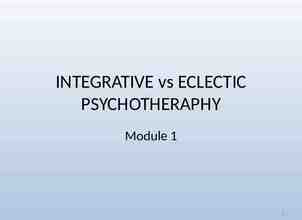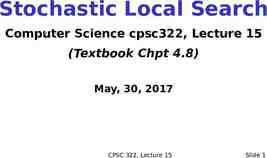Centers Centers for for Disease Disease Control Control and and
17 Slides3.04 MB

Centers Centers for for Disease Disease Control Control and and Prevention Prevention National Center for Emerging and Zoonotic Infectious Diseases Implementation of Enhanced Barrier Precautions in Nursing Homes to Prevent Spread of Multidrug-resistant Organisms

Definitions of Common Terms and Abbreviations Multidrug-resistant Organism (MDRO): bacteria or fungi resistant to multiple antimicrobials Colonization: germ is found on or in the body but is not causing infection

Presentation Outline 1. 2. 3. 4. Impact and burden of MDROs in nursing homes Need for Enhanced Barrier Precautions (EBP) Indications for and use of EBP How to be successful

MDROs Have Significant Impact in Nursing Homes Many nursing home residents are unknowingly colonized with an MDRO, especially residents with risk factors like indwelling medical devices or wounds Residents who have an MDRO can develop serious infections, remain colonized for long time periods, and spread MDROs to others Healthcare personnel can spread MDROs through contaminated hands and clothing

The Large Burden of MDROs in Nursing Homes Facility Type Documented MDRO Actual MDRO Nursing Homes (n 14) 17% 58% Ventilator-Capable Nursing Homes (n 4) 20% 76% McKinnell JA et al, Clin Infect Dis. 2019; 69(9):1566-1573

Need for Enhanced Barrier Precautions (EBP) Historically, interventions in nursing homes have focused only on residents who are actively infected with an MDRO Need for a broader approach to reduce the spread of MDROs without isolating residents for long periods of time Recent studies have indicated the use of EBP can effectively reduce the spread of MDROs

Indications for Enhanced Barrier Precautions EBP are indicated for nursing home residents with any of the following: Infection or colonization with an MDRO when Contact Precautions do not otherwise apply Wounds and/or indwelling medical devices EBP is not limited to outbreaks or specific MDROs

Enhanced Barrier Precautions Use of gown and gloves during high-contact resident care activities No private room required Residents can participate in group activities Intended to be used for resident’s entire length of stay

How to Be Successful Hand Hygiene Environmental Cleaning and Disinfection Enhanced Barrier Precautions Auditing Communicatio n

Resources for Enhanced Barrier Precautions Implementation of Personal Protective Equipment (PPE) Use in Nursing Homes to Prevent Spread of Multidrug-resistant Organisms (MDROs) https://www.cdc.gov/hai/containment/PPE-Nursing-Homes.html Frequently Asked Questions (FAQs) about Enhanced Barrier Precautions in Nursing Homes https://www.cdc.gov/hai/containment/faqs.html Considerations for Use of Enhanced Barrier Precautions in Skilled Nursing Facilities https://www.cdc.gov/hicpac/workgroup/EnhancedBarrierPrecautions.html?msclkid 39038417aed311e c8c868e1e03c50297 Enhanced Barrier Precautions Letter to Nursing Home Residents, Families, Friends, and Volunteers https://www.cdc.gov/hai/pdfs/containment/Letter-Nursing-Home-Residents-Families-Friends.pdf Enhanced Barrier Precautions Letter to Nursing Home Staff https://www.cdc.gov/hai/pdfs/containment/Letter-Nursing-Home-Staff.pdf

Thank you. For more information, contact CDC 1-800-CDC-INFO (232-4636) TTY: 1-888-232-6348 www.cdc.gov The findings and conclusions in this report are those of the authors and do not necessarily represent the official position of the Centers for Disease Control and Prevention.

Optional Q&A

Question #1: Which residents should be placed into Enhanced Barrier Precautions? EBP are indicated for nursing home residents with any of the following: Infection or colonization with an MDRO when Contact Precautions do not otherwise apply Wounds and/or indwelling medical devices

Question #2: Which activities are included under "providing hygiene"? Providing hygiene refers to practices such as brushing teeth, combing hair, and shaving Many of the high-contact resident care activities listed in the guidance are commonly bundled as part of morning and evening care for the resident rather than occurring as multiple isolated interactions with the resident throughout the day Isolated combing of a resident’s hair that is not otherwise bundled with other high-contact resident care activities would not generally necessitate use of a gown and gloves

Question #3: The guidance advises using EBP for the “care and use” of indwelling medical devices. What does that mean? The safest practice would be to wear a gown and gloves for any care (e.g., dressing changes) or use (e.g., injecting or infusing medications or tube feeds) of the indwelling medical device It may be acceptable to use gloves alone for some uses of a medical device that involves only limited physical contact between healthcare worker and resident (e.g., passing meds through a feeding tube) Facilities should define these limited contact activities in their policies and procedures and educate healthcare personnel to ensure consistent application of Enhanced Barrier Precautions

Question #4: What is the definition of “indwelling medical device”? An indwelling medical device provides a direct pathway for pathogens in the environment to enter the body and cause infection Examples include, but are not limited to, central vascular lines (including hemodialysis catheters), indwelling urinary catheters, feeding tubes, and tracheostomy tubes Devices that are fully embedded in the body, without components that communicate with the outside, such as pacemakers, would not be considered an indication for Enhanced Barrier Precautions

Question #5: Are gowns and gloves recommended for EBP when transferring a resident from a wheelchair to chair in the dayroom or dining room? In general, gowns and gloves would not be recommended when performing transfers in common areas such as dining or activity rooms, where contact is anticipated to be shorter in duration Outside the resident’s rooms, EBP should be followed when performing transfers or assisting during bathing in a shared/common shower room and when working with residents in the therapy gym, specifically when anticipating close physical contact while assisting with transfers and mobility






